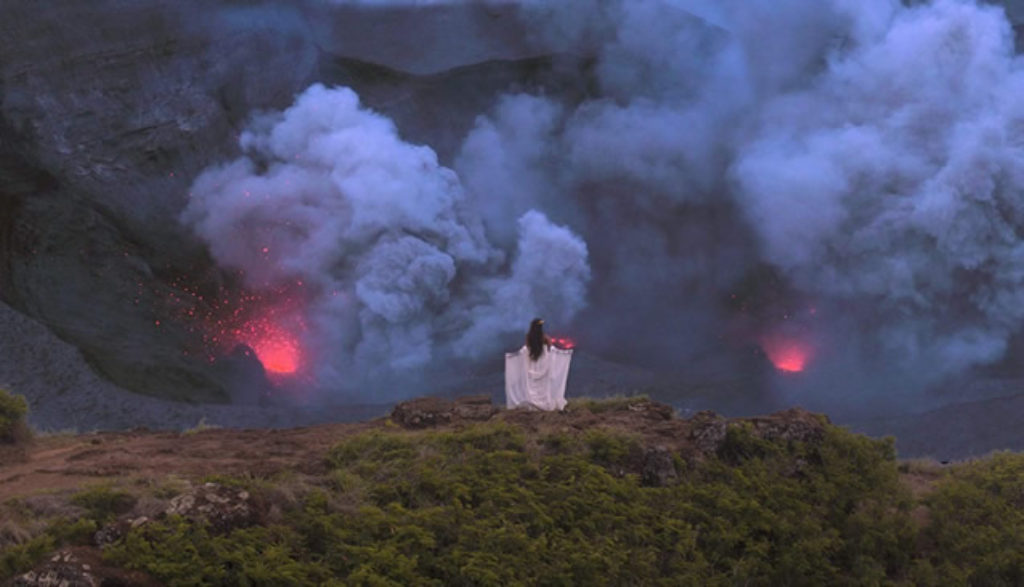
In 1820, a group of three missionaries—John and Mary Thornton, and Hiram Bingham—came to the islands of Hawaii to share the gospel of Jesus Christ. Eager and filled with expectant joy, they were quickly dismayed.
Instead of being warmly welcomed, the missionaries were suspiciously regarded by the native peoples, who were accustomed to the destructive, violent ways of colonization and trade. But there was one native who cautiously opened her village to the missionaries: Chiefess Kapi’olani.
A young, strong chiefess, Kapi’olani was no stranger to this “good news” that the missionaries spoke of. But her people already had a god: Pe’le, the goddess of the volcano. And Pe’le was a jealous diety, requiring human sacrifice to appease her wrath and keep her destructive, molten lava at bay.
Tradition and years of service to Pe’le would not be overturned in a day. But the patient service of Henry, Mary and Hiram began to open the doors of conversation. And that, eventually, paved the pathway for Chiefess Kapi’olani to do the unthinkable and take a stand against Pe’le herself.
Henry Thornton and Hiram Bingham strive to be faithful missionaries, even when tested. Although both of them face moments of doubt, difficulty and persecution, they persevere. Hiram, for example, gets hit by a group of sailors but chooses not to defend himself and to pray for his enemies instead.
[Spoiler Warning] Hiram Bingham offers himself as a sacrifice in the place of a native man (although he’s saved before his death). Hiram’s act of courage and selflessness prompts Chiefess Kapi’olani to prove to her people that God is real by descending into the mouth of a volcano and returning, unscathed. The chiefess becomes a brave, fearless, dignified leader.
Mary is initially a terrible witness for Christ as she complains and refuses to try and adapt to her surroundings. However, she eventually apologizes to her husband and those around her for her poor attitude and bigotry.
Henry, Mary and Hiram tell the natives that they want to help them in any way that they can, such as caring for the sick.
Because of the missionaries’ efforts, many native Hawaiians eventually embrace the Good News.
That said, it’s not an overnight process. Initially, many of the natives whom the missionaries meet believe that they’re only there to convert them and to force them to worship a god other than Pe’le. The people are hesitant to believe in a “new” God, especially Chiefess Kapi’olani. She tells the missionaries that she and her people already have many gods and do not need another.
This prompts each of the missionaries, over time, to live their lives as examples for Christ so that the natives begin to ask questions about Jesus. Slowly, the missionaries are able to share as they sing hymns, read from the Psalms, quote Scripture and live among the people.
However, it is really Chiefess Kapi’olani who wins her people over for Christ. She begins to want a god of justice and mercy, not a god of vengeance and spite. In the end, the chiefess tells her people that they may worship whomever they choose, but that she will worship and serve God. She also declares that her courage is born from the love of God, a love she searched for her entire life.
The village priestess convinces the islanders that the sins of previous generations follow them and that they are cursed for allowing the missionaries to inhabit their land. Similarly, they’re taught that with death their spirits are released to appease Pe’le.
Mary tells Chiefess Kapi’olani that she and her people are practicing “pagan barbarism” by sacrificing humans to appease their volcano god, Pe’le.
We often hear phrases such as “God will help us” and “God is in control” from the missionaries. Many conversations are had about Jesus’ sacrifice, redemption, God’s will, salvation and confession. Missionaries and native peoples alike pray to God for help and strength. A man exclaims “for the love of God” in a moment of extreme anguish.
Chiefess Kapi’olani says that many foreigners were only interested in “possessing” the native women, an obvious allusion to using or mistreating them sexually. A group of sailors confirm her words as they describe wanting to “take” women. Similarly, they ask a missionary if they’re sinning by “whoring” around.
The Hawaiian men wear loincloths and we see partial rear nudity as they walk around. Henry and Mary hold hands.
The priestess demands that the people of the island begin sacrificing humans to Pe’le, the goddess of the volcano, even though human sacrifice was previously outlawed. A group of men gathers together to capture an innocent man; They sacrifice him by stabbing him in the throat as he lies on an altar (we only see the blade raised). Other would-be “sacrifices” try to flee the ceremony, but they’re hit with wooden spears and beaten with other weapons.
The island priestess threatens to kill the missionaries and tells other followers to kill them. A man gets shot in the leg and blood runs down his thigh. A group of tribal leaders threaten to drown an innocent man.
Henry slaps Mary in the face after she falsely accuses him of wanting to sleep with other women. There’s reference to past pillaging by pirates. Hiram tells a group of men that he previously lost his wife and child.
We hear the British vulgarity “bloody.” A few men are called “fools.” The Hawaiian natives are often called “savages” and “barbarians.”
Mary once says of the Hawaiians, “I hate these filthy, worthless savages.” Elsewhere, Mary tells her husband, Henry, that she hates him and curses the day they met.
There’s reference to the consumption of rum and whisky.
Mary, while she slowly begins to love the people, begins as a terrible example for Christ, complaining and denouncing God’s power. Mary also refuses food and sustenance for a long time and begins to wither away.
Based on the true story of a group of missionaries who came to the islands of Hawaii in 1820, The Islands chronicles a chapter of history about a group of missionaries who brought the Gospel of Christ to Hawaii.
Director Tim Chey said of it, “The world needs a Savior right now, and we hope to bring light to a dark world via cinema.” The Islands focuses on the faith of the missionaries at the heart of this story as well as the courage of Chiefess Kapi’olani—courage that paved way for the spread of Jesus’ message in a land that had been largely hostile to it.
This modest Christian film (starring Mira Sorvino) isn’t getting a huge release as it goes up against Hollywood heavyweights this Christmas season. And while it may not have the production budget of a typical action blockbuster, for those interested in a redemptive historical story, the heart of this film illustrates the value of perseverance and the power of Christ.


Kristin Smith joined the Plugged In team in 2017. Formerly a Spanish and English teacher, Kristin loves reading literature and eating authentic Mexican tacos. She and her husband, Eddy, love raising their children Judah and Selah. Kristin also has a deep affection for coffee, music, her dog (Cali) and cat (Aslan).